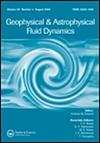Weakly nonlinear analysis of mean flow generation for tidally locked exoplanets
IF 1.1
4区 地球科学
Q3 ASTRONOMY & ASTROPHYSICS
Geophysical and Astrophysical Fluid Dynamics
Pub Date : 2021-02-04
DOI:10.1080/03091929.2021.1877698
引用次数: 0
Abstract
We study a model developed by Showman and Polvani [Equatorial superrotation on tidally locked exoplanets. Astrophys. J. 2011, 738, 71–94] to study the behaviour of a thin, upper atmospheric layer of a tidally locked exoplanet; in particular, the behaviour of the atmospheres of “hot Jupiters”, gas giants orbiting close to their stars and tidally locked to them, having a dayside and a nightside. We are interested in trying to elucidate the mechanism found by Showman and Polvani for the generation on such planets of an equatorial superrotation, ie. a rapid easterly current in the region about the equator. We extend their analysis of the two simple linear cases studied in the appendices of their paper by including the (small) nonlinear terms which then interact to generate mean flows. In the first of these cases, we expand about the small radiative time scale and find that the mean flow at the equator is eastward, This case may be particularly relevant for the hottest of tidally locked exoplanets. In the other case, we use a multiple parameter asymptotic expansion where the drag time scale is very large but much less than the reciprocal of the small amplitude scale of the expansion. In this case, we again find that the nonlinear terms generate a mean flow that is eastward at the equator. These results may help to provide a possible explanation for the equatorial superrotation.潮汐锁定系外行星平均流量产生的弱非线性分析
我们研究了Showman和Polvani[潮汐锁定系外行星的赤道超旋转]开发的模型。12,54。[j] .地球科学进展,2011,32(1):1 - 4。特别是“热木星”的大气行为,这些气体巨星绕着它们的恒星运行,并潮汐地锁定在它们身上,有一个白天的一面和一个晚上的一面。我们感兴趣的是试图阐明由Showman和Polvani发现的在赤道超旋转的行星上产生的机制。赤道附近地区快速的东流。我们扩展了他们在论文附录中研究的两个简单线性情况的分析,包括(小)非线性项,然后相互作用产生平均流。在第一种情况下,我们扩大了小辐射时间尺度,发现赤道的平均流量是向东的,这种情况可能与最热的潮汐锁定系外行星特别相关。在另一种情况下,我们使用多参数渐近展开式,其中拖拽时间尺度非常大,但远小于展开式小幅度尺度的倒数。在这种情况下,我们再次发现非线性项在赤道处产生向东的平均流。这些结果可能有助于为赤道超自转提供一种可能的解释。
本文章由计算机程序翻译,如有差异,请以英文原文为准。
求助全文
约1分钟内获得全文
求助全文
来源期刊

Geophysical and Astrophysical Fluid Dynamics
地学天文-地球化学与地球物理
CiteScore
3.10
自引率
0.00%
发文量
14
审稿时长
>12 weeks
期刊介绍:
Geophysical and Astrophysical Fluid Dynamics exists for the publication of original research papers and short communications, occasional survey articles and conference reports on the fluid mechanics of the earth and planets, including oceans, atmospheres and interiors, and the fluid mechanics of the sun, stars and other astrophysical objects.
In addition, their magnetohydrodynamic behaviours are investigated. Experimental, theoretical and numerical studies of rotating, stratified and convecting fluids of general interest to geophysicists and astrophysicists appear. Properly interpreted observational results are also published.
 求助内容:
求助内容: 应助结果提醒方式:
应助结果提醒方式:


